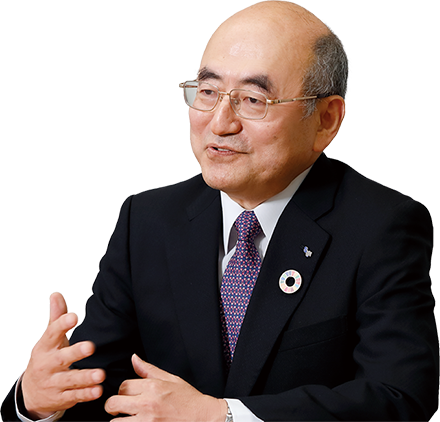Messages from Outside Directors Osami Sagisaka
Osami Sagisaka
Outside Director
Worked in the Ministry of Home Affairs, the Fire and Disaster Management Agency and the Ministry of the Environment, before serving as a part-time lecturer at Waseda University and a Consultant at Hideaki Ozawa Law Office. Served as Vice Chairman of Emergency Medical Network of Helicopter and Hospital (HEM-Net), Chairperson of Saitama International Association and Director of Japan Municipal Training and Research Foundation was appointed as Director of the Company in June 2019.

Director Sagisaka, please tell us about the agenda and discussions that made an impression on you in meetings of the Board of Directors for the fiscal year ended March 31, 2024.
The most important role of an Outside Director is to supervise the execution of duties by the management team, and at meetings of the Board of Directors, I am conscious of participating in discussions from an objective standpoint that represents the opinions of minority shareholders. In addition, I have the impression that our Board of Directors always has meticulous discussions based on quite detailed materials.
In meetings of the Board of Directors last year, there were several occasions when proposals related to M&A were submitted, and matters such as the evaluation of corporate value of the companies being considered for acquisition and the calculation of synergistic effects were based on extremely precise estimates. Active discussions are taking place based on such quantitative and qualitative information, and the Board of Directors evaluates that sound management is being carried out.
How do you evaluate the issues that the Tokyo Stock Exchange (TSE) requested you to consider for “Action to Implement Management that is Conscious of Cost of Capital and Stock Price”?
As I mentioned earlier, our discussions in the Board of Directors are based on quantitative and qualitative data. In addition, indicators for measuring corporate management efficiency, such as ROE, have been presented at various milestones, and we believe that the Company's management team is sufficiently conscious of the cost of capital and capital efficiency. In response to TSE's request for “Action to Implement Management that is Conscious of Cost of Capital and Stock Price,” we have disclosed our current response status after discussing it in meetings of the Board of Directors, but we recognize that we need to continue to update it in the future in order to achieve sustained growth and improve corporate value over the medium to long term.
Please tell us your thoughts on cash allocation with a view to enhancing corporate value over the medium to long term.
We believe it is important to allocate funds in a balanced way between growth investment and shareholder returns. In the logistics industry, while the 2024 problem is becoming a reality, efforts to address the shortage of transportation capacity are progressing, but this is not a problem that will be resolved by 2024, and it is necessary to take action with an eye to 2025, 2026, and beyond. To achieve this, we must not only respond to the immediate problems of insufficient transport capacity and labor shortages, but also invest in solving these issues in ways that will lead to medium- to long-term growth. First of all, the growth investment I am most focused on is investment in DX. We recognize that there are still many tasks that need to be performed by people in the labor-intensive logistics industry. We believe that replacing these areas with information systems and robots to improve efficiency and save labor is an important initiative that will not only solve the labor shortage problem, but also make it possible to develop services that have not been available until now, and I have very high expectations for this. I also think that efforts to improve efficiency through the large-scale transfer centers currently under construction, as well as M&A that contributes to the growth of the entire SG Holdings Group, will also be important factors in future business growth.
It is also very important to return the cash generated by such growth investments to shareholders. We are focusing on allocating funds to growth investments in addition to maintaining and improving the level of shareholder returns, while keeping an eye on the overall balance.
Please tell us about your evaluation of the Company's efforts to achieve carbon neutrality and the issues it faces.
Since 1997, when the Kyoto Protocol was signed, the Group has been very proactive in its environmental initiatives as a company based in Kyoto. In April 2022, we announced our “Decarbonization Vision” and are working towards our goal of achieving carbon neutrality by 2050, such as introducing renewable energy into our own logistics facilities, introducing environmentally friendly vehicles such as EVs, and creating logistics solutions with low environmental impact.
Of these, initiatives aimed at utilizing renewable energy are progressing ahead of the targets announced for FY2030. In terms of emissions from facilities, it is anticipated that regulations will become more stringent in the future, with the aim of achieving zero emissions. For this reason, I think it is important not only to respond to the shift to renewable energy, but also to give back to the world by more actively building warehouses and sales offices in new ways to contribute to reducing GHG emissions. Although the introduction of environmentally friendly vehicles is still in the verification stage, the process of switching light vehicles to EVs is progressing. Meanwhile, the early introduction for trucks is difficult at present due to technical constraints, so we recognize that we are at a stage where we need to pay attention to the progress of technology and product development by transportation equipment manufacturers while considering the issue.
In order to achieve carbon neutrality, it is important to reduce GHG emissions throughout the entire supply chain, from upstream to downstream. The GHG emissions of partner companies to whom we outsource work such as long-haul transportation and the Last One Mile are included in Scope 3 for the Group. Given that the Company's overall business is composed of coordination with a variety of partner companies, I think it will become increasingly important in the future to not only work on initiatives to reduce our own GHG emissions, as I mentioned earlier, but also to take into account measures to reduce GHG emissions by partner companies.
The Japanese government has set goals to achieve carbon neutrality by 2050 and to reduce GHG emissions by 46% compared to FY2013 by FY2030, and strategies and measures to achieve these goals are being discussed in various settings. In May 2023, the GX Promotion Act was passed to encourage a variety of measures to decarbonize companies. In this way, as the social environment changes at a speed faster than anticipated, we have established a Sustainability Committee (chaired by the Chairperson and CEO) to discuss and promote measures to enhance non-financial corporate value based on the latest trends in sustainability, such as carbon neutrality.
In order to continue to enhance corporate value while responding to changes in the external environment, we believe it is important to continue to review and make improvements by applying the PDCA cycle. I expect that our company will actively work with partner companies and customers to reduce GHG emissions throughout the entire supply chain to realize carbon neutrality, and achieve an increase in corporate value.
Click here for other messages from Outside Diectors




